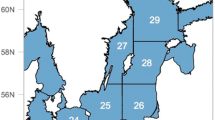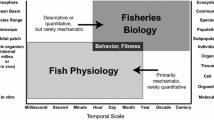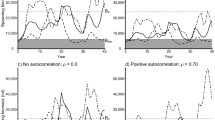For most of its history, fisheries science has focused on the dynamics of single populations. Ecosystem considerations have gained prominence in recent decades, with attention given to predation and prey shortages as sources of mortality and environmental features as drivers of variation in recruitment, growth, and maturity. However, these are still population-based considerations, just linking the population dynamics to components of the ecosystem in which the species lives.
Access this chapter
Tax calculation will be finalised at checkout
Purchases are for personal use only
Preview
Unable to display preview. Download preview PDF.
Similar content being viewed by others
References
Anderson, E.A. (1998) The history of fisheries management and scientific advice: the ICNAF/ NAFO history from the end of World War II to the present. Journal of Northwest Atlantic Fisheries Science 23: 75–94.
Anderson, E.A. (ed) (2000) 100 Years of Science Under ICES: A symposium held in Helsinki 1–4 August 2000. ICES Marine Science Symposia # 215. ICES, Copenhagen.
Anonymous (1997) Forage Fishes in Marine Ecosystems. Lowell Wakefield Fisheries Symposium Series 14, Alaska Sea Grant AK-SG-97-01. Fairbanks, AK. 828 pp.
Aqorau, T. (2003) Obligations to protect marine ecosystems under international Conventions and other legal instruments. In Sinclair, M., Valdimarsson G. (eds) Responsible Fisheries in the Marine Ecosystem. FAO, Cambridge, pp 25–40.
Bakun, A. (1996) Patterns in the Ocean: Ocean Processes and Marine Population Dynamics. California Sea Grant, San Diego, CA, 323 pp.
Barnes, P.W., Thomas, J.P. (eds) (2005) Benthic Habitats and the Effects of Fishing. American Fisheries Society Symposium 41. AFS, Washington, DC, 890 pp.
Beamish, R.J., McFarlane, G.A., King, J.A. (2004) Regimes and the history of the major fisheries off Canada's west coast. Progress in Oceanography 60: 355–385.
Berkes, F., Colding, J., Folke, C. (2000) Rediscovery of traditional ecological knowledge as adaptive management. Ecological Applications 10: 1251–1262.
Beverton, R.J.H., Holt, S.J. (1957) On the Dynamics of Exploited Fish Populations. Fisheries Investigations Series II:19, UK Ministry of Fisheires, Lowestoft, UK.
Brander, K., Mohn, R. (2004) Effect of the North Atlantic oscillation on recruitment of Atlantic cod (Gadus morhua). Canadian Journal of Fisheries and Aquatic Sciences 61: 1558–1564.
Bromley, D.W. (1991) Environment and Economy: Property Rights and Public Policy. Blackwell, Cambridge.
Browman, H.L., Stergiou, K.I. (eds) (2006) Politics and socio-economics of ecosystem-based management of marine resources. Marine Ecology Progress Series 2006: 1–73.
Butterworth, D.S., Punt, A.E. (2003) The role of harvest control laws, risk and uncertainty and the precautionary approach in ecosystem-based management. In Sinclair, M., Valdimarsson G. (eds) Responsible Fisheries in the Marine Ecosystem. FAO, Rome, pp 311–319.
Carscadden, J.E., Montevecchi, W.A., Davoren, G.K., Nakashima, B.S. (2002) Trophic relationships among capelin (Mallotus villosus) and seabirds in a changing ecosystem. ICES Journal of Marine Science 59: 1027–1033.
CBD (2006) Convention on Biological Diversity Programs and Issues: Protected Areas. http:// www.biodiv.org/programmes/cross-cutting/protected/default.asp
Charles, A.T. (2001) Sustainable Fishery Systems. Fish and Aquatic Resources Series No. 5. Blackwell Science, Oxford, 370 pp.
Clark, C.W. (1990) Mathematical Bioeconomics — The Optimal Management of Renewable Resources. Wiley, New York.
Copes, P., Charles, A.T. (2004) Socioeconomics of individual transferable quotas and community-based fishery management. Agricultural and Resource Economics Review 17: 171–181.
Costanza, R. (2006) Thinking broadly about costs and benefits in ecological management. Integrated Environmental Assessment and Management 2: 166–173.
CSAS (2007) Guidance document on identifying conservation priorities and phrasing conservation objectives for large ocean management areas. CSAS Science Advisory Report 2007: 02.
Cury, P., Shannon, L., Shin, Y.-J. (2003) The functioning of marine ecosystems: a fisheries perspective. In Sinclair, M., Valdimarsson G. (eds) Responsible Fisheries in the Marine Ecosystem. FAO, Rome, pp 103–123.
Devlin, R.A., Grafton, R.Q. (1998) Economic Rights and Environmental Wrongs: Property Rights for the Common Good. Edward Elgar Press, Cheltenham.
DFO (2006) Ocean Action Plan: Integrated management. www.dfo-mpo.gc.ca/oceans/management-gestion/integratedmanagement-gestionintegree.
Durrenburger, E.P., King, T.D. (eds) (2000) State and Community in Fisheries Management: Power, Policy, and Practice. Bergen and Garvey Press, Westport, CT.
Elmqvist, T., Folke, C., Nystrom, M., Peterson, G., Bengtsson J., Walker, B., Norberg, J. (2003) Response diversity, ecosystem change, and resilience. Frontiers in Ecology and Environment 1: 488–494.
European Community (1992) Council Directive 92/43 on the Conservation of Natural Habitats and of Wild Fauna and Flora. http://www.jncc.gov.uk/page = 1374
European Community (2005) Directive of the European Parliament and of the Council establishing a Framework for Community Action in the field of Marine Environmental Policy (Marine Strategy Directive) [SEC (2005) 1290], In COM(2005) 505 Final, pp. 31, Brussels.
European Community (2007) European Fisheries: General Information. http://ec.europa.eu/ fisheries/faq/general_en.htm
FAO (1999) Report of the Meeting of the FAO AD HOC Expert Group on Listing Criteria for Marine Species under CITES, Cape Town, South Africa, 20 November 1998. COFI/99/Inf.16 Part II. http://www.fao.org/docrep/meeting/x0702e.htm
FAO (2000) An appraisal of the suitability of the CITES criteria for listing commercially exploited aquatic species. FAO Fisheries Circular No. 954. 66 pp.
FAO (2001) Product certification and ecolabelling for sustainability. FAO Fisheries Technical Paper 442: 83.
FAO (2002) International Plan of Action for the Conservation and Management of Sharks. http:// www.fao.org/fi/website/FIRetrieveAction.do?dom = org&xml = ipoa_sharks.xml
FAO (2003) The Ecosystem Approach to Fisheries. FAO Technical Guidelines for Responsible Fisheries. No. 4, Suppl. 2, 112 pp. FAO, Rome. ftp://ftp.fao.org/ docrep/fao/005/y4470e/ y4470e00.pdf
Grafton, R.Q. et al. (2006). Incentive-based approaches to sustainable fisheries. Canadian Journal of Fisheries and Aquatic Science 63: 699–710.
Greenpeace (2006) Defending Our Oceans: A Map of Proposed High Seas Marine Protected Areas. http://oceans.greenpeace.org/en/documents-reports/roadmap
Greenstreet, S.P.R., Rogers, S.I. (2006) Indicators of the health of the North Sea fish community: identifying reference levels for an ecosystem approach to management. ICES Journal of Marine Science 63: 573–593.
Grey, T.S. (ed) (2005) Participation in Fisheries Governance. Kluwer/Springer, The Netherlands.
Gundersen, L.H., Pritchard, L. (eds) (2002) Resilience and the Behaviour of Large-Scale Systems. Island Press, Washington, DC.
Hall, S.J. (1999) The Effects of Fishing on Marine Ecosystems and Communities. Blackwell, Oxford, 396 pp.
Hanna, S., Folke, C., Maler, K.-G. (eds) (1996) Rights to Nature: Ecological, Economics, Cultural and Political Principles of Institutions for the Environment. Island Press, Washington, DC.
Hannesson, R. (1993) Bioeconomic Analysis of Fisheries an FAO Fishing Manual. Blackwell, Oxford, 144 pp.
Harwood, J., Stokes, K. (2003) Coping with uncertainty in ecological advice: lessons from fisheries. Trends in Ecology and Evolution 18: 617–622.
Hewitt, J.E., Anderson, M.J., Thrush, S.F. (2005) Assessing and monitoring ecological community health in marine systems. Ecological Applications 15: 942–953.
Hilborn, R.L., Garcia, S., et al. (2004) When can marine protected areas improve fisheries management? Ocean and Coastal Management 47: 197–205.
Hollowed, A.B., Bax, N., Beamish, R.J., Collie, J., Fogarty, M., Livingston, P., Pope, J.G., Rice, J.C. (2000) Are multispecies models an improvement on single species models for measuring fishing impacts on marine ecosystems?. ICES Journal of Marine Science 57: 707–719.
Hughes, T.P., Bellwood, D.R., Folke, C., Steneck, R.S., Wilson, J. (2005) New paradigms for supporting resilience of marine ecosystems. Trends in Ecology and Evolution 20: 380–386.
ICES (2002) Report of the Advisory Committee on Fisheries Management 2001. ICES Cooperative Research Report 255 (3 vols).
ICES (2005) Report of the Study Group on Management Strategies, ICES CM/2005/ ACFM:09. 72 pp. http//:www.ices.dk/reports/ACFM/2005/SGMAS/SGMAS05.pdf
ICES (2006a) Report of the Working Group on Ecosystem Effects of Fishing ICES CM 2006 Ace:05. http://www.ices.dk/reports/ACE/2006/WGECO06.pdf
ICES (2006b) Report of the Study Group on Management Strategies. ICES CM 2006/ ACFM:15, 165 pp.
ICES (2007) Report of the Working Group on Regional Ecosystem Descriptions ICES CM 2007:ACE/01, 160 pp.
Jennings, S., Freeman, S., Parker, R., Duplisea, D.E., Dinmore, T.A. (2005) Ecosystem consequences of bottom fishing disturbance. American Fisheries Society Symposium 41: 73–90.
Jorgensen, S.E., Costanza, R., Xu, F.-L. (eds) (2005) Ecological Indicators for Assessment of Ecosystem Health. CRC Press, Boca Raton, FL, 439 pp.
Kell, L.T., Pastoors, M.A., Scott, R.D., Smith, M.T., Van Beek, F.A., O'Brien, C.M., Pilling, G.M. (2005) Evaluation of multiple management objectives for Northeast Atlantic flatfish stocks: sustainability vs. stability of yield. ICES Journal of Marine Science 62: 1104–1117.
King, J.R. (ed) (2005) Report of the Study Group on the Fisheries and Ecosystem Responses to Recent Regime Shifts. PICES Science Report No. 28, 162 pp.
Koen-Alonso, M., Yodzis, P. (2005) Multispecies modelling of some components of the marine community of northern and central Patagonia, Argentina. Canadian Journal of Fisheries and Aquatic Sciences 62: 1490–1512.
Kooijman, S.A.L M. (2000) Dynamic energy and mass budgets in biological systems. Cambridge University Press, New York.
Kruse, G.H. et al. (2001) Spatial processes and management of marine populations. University of Alaska Sea Grant AK-SG-01-02. Fairbanks, AK, 720 pp.
Marine Stewardship Council (2004) MSC Principles and Criteria for Sustainable Fisheries. http:// www.msc.org/html/
Murawski, S.A., Brown, R., Lai, H.L., Rago, P.J., Hendrickson, L. (2000) Large-scale closed areas as a fishery management tool in temperate marine systems: the Georges Bank experience. Bulletin of Marine Science 66: 755–798.
Neis, B., Felt, L. (eds) (2001) Finding our sea legs: Linking fishery people and their knowledge with science and management. ISER Books, St. John's.
Nicholson, M.D., Jennings, S.J. (2004) Testing candidate indicators to support ecosystem-based management: the power of monitoring surveys to detect temporal trends in fish community metrics. ICES Journal of Marine Science 61: 35–42.
NOAA (2003) Social Science Research Within NOAA: Review and Recommendations. Final Report to the NOAA Science Advisory Board by the Social Science Review Panel, Washington, DC.
NOAA (2005) Puget Sound Salmon Recovery Plan. http://www.noaa.gov/salmon_recovery_planning/ RecoveryDomains/PugetSoundPlan/ExecSumm.pdf
NOAA (2006a) The Status of US Fisheries — 2006. http://www.nmfs.noaa.gov/sfa/statusoffisheries/ SOSmain.htm
NOAA (2006b) NOAA External Ecosystem Task Team Report. http://ecosystems.noaa.gov/docs/ EETt.pdf
Olsson, T., Folke, C., Berkes, F. (2004) Adaptive co-management for building resilience in social-ecological systems. Environmental Management 34: 75–90.
Pastoors, M.A., Rijnsdorp, A.D., Van beek, F.A. (2000) Effects of a partially closed area in the North Sea (“plaice box”) on stock development of plaice. ICES Journal of Marine Science 57: 1014–1022.
Peterman, R.M. (2002) Eco-certification: an incentive for dealing effectively with uncertainty, risk, and burden of proof in fisheries. Bulletin of Marine Science 70: 669–681.
PICES (2005) Marine Ecosystems of the North Pacific (Bering Sea Chapter). PICES Special Publication 1. http://www.pices.int/publications/special_publications/NPESR/2005/ File_9_pp_153_176.pdf
Pikitch, E.K., Santora, C., Babcock, E.A., Bakun, A., Bonfil, R., Conover, D.O., Dayton, P., Doukakis, P., Fluharty, D., Heneman, B., Houde, E.D., Link, J., Livingston, P.A., Mangel, M., McAllister, M.K., Pope, J., Sainsbury, K.J. (2004) Ecosystem-based fishery management. Science 305: 346–347.
Plaganyi, E.E., Butterworth, D.S. (2004) A critical look at the potential of ECOPATH with ECOSIM to assist in practical fisheries management. South African Journal of Marine Science 26: 261–287.
Pope, J.G. (1991) The ICES Multispecies Assessment working Group: evolution, insights, and future problems. pp 22–33 in M. Sissenwine and N. Daan (eds) Multispecies Models relevant to Management of Living Marine Resources. ICES Marine Science Symposium 193.
Rice, J.C. (2003) Environmental health indicators. Ocean and Coastal Management 46: 235–259.
Rice, J.C. (ed) (2005a) Ecosystem effects of fishing: impacts, metrics, and management strategies. ICES Cooperative Research Report 272: 177.
Rice, J.C. (2005b) Understanding fish habitat ecology to achieve conservation. Journal of Fish Biology 67(Suppl B): 1–22.
Rice, J.C. (2008) An ecologist's view of economic instruments and incentives. International Journal of Global Environmental Issues 7: 191–204.
Rice, J.C., Rochet, M.-J. (2005) A framework for selecting a suite of indicators for fisheries management. ICES Journal of Marine Science 62: 516–527.
Rice, J.C., Trujillo, V., Jennings, S., Hylland, K., Hagstrom, O., Astudillo, A., Jensen, J.N. (2005) Guidance on the application of of the ecosystem approach to management of human activities in the European marine environment. ICES Cooperative Research Report 273: 22.
Richards, L.J., Rice J.C. (1996) A framework for reducing implementation uncertainty in fisheries management. North American Journal for Fisheries Management 16: 488–494.
Ricker, W.E. (1975) Computatition and Interpretation of Biological Statistics of Fish Populations. Bulletin of the Fisheries Research Board of Canada 191. 382 pp.
Roberts, C.M., Bohnsack, J.H., Gell, F., Hawkins, J.P., Goodridge, R. (2002) Effects of marine reserves on adjacent fisheries. Science 294: 1921–1923.
Rozwadowski, H.M. (2002) The Sea Knows No Boundaries: A Century of Marine Science Under ICES. University of Washington Press, Seattle, WA, 410 pp.
Sainsbury, K., Sumaila, U.R. (2003) Incorporating ecosystem objectives into management of sustainable marine fisheries, including ‘best practice’ reference points and use of marine protected areas. In Sinclair, M., Valdimarsson, G. (eds) Responsible Fisheries in the Marine Ecosystem. FAO, Cambridge, pp 343–362.
Schrum, C., Alekseeva, I., St. John, M. (2006) Development of a coupled physical-biological ecosystem model ECOSMO Part I: model description and validation for the North Sea. Journal of Marine Systems 61: 79–99.
Scott, A. (1998) Cooperation and quotas. In Pitcher, T.J. et al. (eds) Reinventing Fisheries Management. Fish and Fisheries Series # 23. Kluwer, Dordrecht, pp 201–214.
Shannon, L.J., Moloney, C.L., Jarre, A., Field, J.G. (2003) Trophic flows in the southern Benguela during the 1980s and 1990s. Journal of Marine Systems 39: 83–116.
Shotten, R. (ed) (2000) Current property rights systems in fisheries management; Proceedings of a Conference, Freemantle W.A.. FAO Fisheries Technical Paper 404: 684.
Smith, T.D. (1994) Scaling Fisheries: The Science of Measuring the Effects of Fishing 1855–1955. Cambridge Scientific Press, Cambridge, 392 pp.
Steffansson, G. (2003) Multi-species and ecosystem models in a management context. In Sinclair, M., Valdimarsson, G. (eds) Responsible Fisheries in the Marine Ecosystem. FAO, Cambridge, pp 171–188.
Tjelmeland, S., Lindstrom, U. (2005). An ecosystem element added to the assessment of Norwegian spring-spawning herring: implementing predation by minke whales. ICES Journal of Marine Science 62: 285–294.
United Nations (1992) United Nations Convention on the Environment and Development. http:// www.unep.org/unep/partners/un/unced/home.htm
United Nations (2002) Plan of Implementation — World Summit on Sustainable Development. New York, 44 pp.
United Nations (2006) Report of the United Nations Open-Ended Informal Consultative Process on Oceans and the Law of the Sea. http://www.un.org/Depts/los/consultative_process/ consultative_process_info.htm
Wilen J.E., Botsford, L.W. (2005) Spatial Management of Fisheries. California Sea Grant College Program. Fisheries Paper 05_01. http://repositories.cdlib.org/csgc/rcr/Fisheries05_01
Author information
Authors and Affiliations
Corresponding author
Editor information
Editors and Affiliations
Rights and permissions
Copyright information
© 2009 Springer Science + Business Media B.V
About this chapter
Cite this chapter
Rice, J.C. (2009). Biodiversity, Spatial Management, and the Ecosystem Approach. In: Beamish, R.J., Rothschild, B.J. (eds) The Future of Fisheries Science in North America. Fish & Fisheries Series, vol 31. Springer, Dordrecht. https://doi.org/10.1007/978-1-4020-9210-7_2
Download citation
DOI: https://doi.org/10.1007/978-1-4020-9210-7_2
Publisher Name: Springer, Dordrecht
Print ISBN: 978-1-4020-9209-1
Online ISBN: 978-1-4020-9210-7
eBook Packages: Biomedical and Life SciencesBiomedical and Life Sciences (R0)




